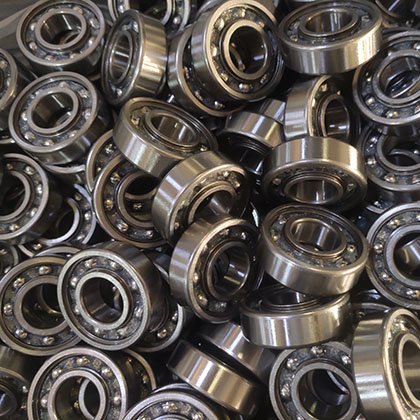
Bearings dimensions
Bearings come in various dimensions, which are determined based on the specific application requirements and the loads they need to support. The dimensions of a bearing typically include:
1. Outer diameter (D): This is the diameter of the outer ring of the bearing, measured from one side to the opposite side. It determines the size of the housing or mounting where the bearing will be installed.
2. Bore diameter (d): This is the inner diameter of the bearing, measured from one side of the inner ring to the opposite side. It determines the size of the shaft that the bearing will fit onto.
3. Chamfer dimensions: Bearings may have chamfers or beveled edges to facilitate installation or improve load distribution. Chamfer dimensions specify the depth and angle of these bevels.
4. Width (B): This is the thickness of the bearing, measured perpendicular to the axis of rotation. It determines the space required for the bearing within the machinery or equipment.
5. Dynamic and static load ratings: Although not strictly dimensions, dynamic and static load ratings are important performance parameters associated with bearings. These ratings indicate the maximum loads that the bearing can withstand under dynamic (rotating) and static (stationary) conditions, respectively. Engineers use these ratings along with bearing dimensions to ensure that the selected bearing can safely support the anticipated loads within the specified operating conditions.
6. Axial clearance: In some cases, axial clearance, or endplay, may also be specified. This is the axial movement allowed between the inner and outer rings of the bearing.
7. Radial clearance: This refers to the internal clearance between the rolling elements and the raceways when the bearing is not mounted. It affects the fit and performance of the bearing and is specified as a range of values.
8. Sealing and shielding dimensions: Bearings may include seals or shields to protect against contamination and retain lubrication. The dimensions of these seals or shields, including their thickness, diameter, and design features, are essential considerations to ensure effective sealing and shielding performance without excessive friction or drag.
9. Mounting dimensions: Proper mounting of bearings is critical for maintaining alignment, minimizing stress concentrations, and preventing premature failure. Mounting dimensions, such as the bore and housing tolerances, clearance or interference fits, and recommended shaft and housing geometries, are provided to guide the installation process and ensure optimal performance and longevity of the bearing.
10. Tolerance and fit: Bearing dimensions also include tolerance specifications, which indicate the allowable deviation from the nominal dimensions. Tolerance levels ensure that bearings can be manufactured consistently and accurately to meet the required performance criteria. Additionally, the fit between the bearing and its mating components, such as the shaft and housing, is crucial for proper operation. Different fit types, such as clearance fit, interference fit, or transition fit, are specified based on application requirements and operating conditions.
11. Overall dimensions: These dimensions encompass the overall size of the bearing, including the outer diameter, width, and sometimes the length (from one side of the inner ring to the other side of the outer ring).
It’s important to note that bearing dimensions can vary widely depending on the type of bearing (e.g., ball bearings, roller bearings), the series or model, and any specific design features required for the application. Engineers and designers must carefully consider these dimensions when selecting bearings to ensure proper fit, alignment, and performance within the machinery or equipment.
About us
DFL Group is based on Hebei DFL Minmet Refractories Corp. Includes Hebei DFL Minmet Refractories Corp., Hong Kong CODO company, NSAR IND LLC in U.S.A., NSAR bearing manufacturing factory and a number of NSAR brand designated manufacturers. Our brands include NSAR, 3D, OWO, CBQ, and NASA .
NSAR bearings management team of managers, engineers, and technical staff have 15 – 25 years experience. We supply customers with bearings not only produced in our own factory, but also produced in professional bearings plants designated by NSAR brand to meet customers’ different requirements, such as pillow block bearings,we have designated a factory in northern China, which has perfect testing equipment and can develop products to customer needs very rapidly. Miniature bearings are arranged in the factory in southern China, which has enjoyed a good reputation long term in producing miniature bearings.
As a professional factory that produces professional products, with professional people doing professional things, our foreign customers have declared: “NSAR bearings have reached a domestic first-class and international brand-name quality, and NSAR bearing prices are 30-50% lower than international similar bearings.”
NSAR, a professional 6000 bearing supplier in China, provides a broad variety of 6000 bearing with best customer service and quality assured. With more than 20 years 6000 bearing manufacture experience, our 6000 bearings has been exported to United States, Canada, Mexico, Brazil, Argentina. NSAR can satisfy your bulk 6000 deep groove ball bearings customization needs,We provide 6012 bearing and 6200 bearings series and 6300 bearing.you can products download.

